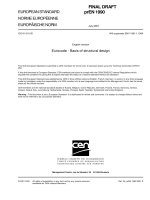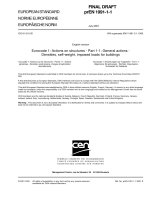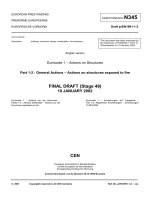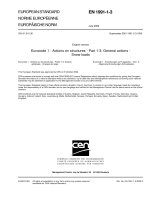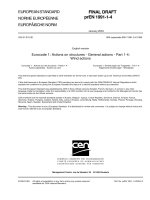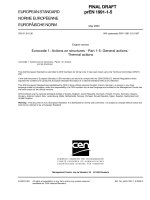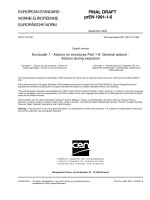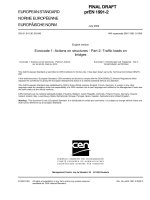Design of masonry structures Eurocode 1 Part 1,5 - prEN 1991-1-5-2003
Bạn đang xem bản rút gọn của tài liệu. Xem và tải ngay bản đầy đủ của tài liệu tại đây (634.13 KB, 47 trang )
EUROPEAN STANDARD
FINAL DRAFT
prEN 1991-1-5
NORME EUROPÉENNE
EUROPÄISCHE NORM
May 2003
ICS 91.010.30
Will supersede ENV 1991-2-5:1997
English version
Eurocode 1: Actions on structures - Part 1-5: General actions Thermal actions
Eurocode 1: Actions sur les structures - Partie 1-5: Actions
sur les structures
This draft European Standard is submitted to CEN members for formal vote. It has been drawn up by the Technical Committee CEN/TC
250.
If this draft becomes a European Standard, CEN members are bound to comply with the CEN/CENELEC Internal Regulations which
stipulate the conditions for giving this European Standard the status of a national standard without any alteration.
This draft European Standard was established by CEN in three official versions (English, French, German). A version in any other
language made by translation under the responsibility of a CEN member into its own language and notified to the Management Centre has
the same status as the official versions.
CEN members are the national standards bodies of Austria, Belgium, Czech Republic, Denmark, Finland, France, Germany, Greece,
Hungary, Iceland, Ireland, Italy, Luxembourg, Malta, Netherlands, Norway, Portugal, Slovak Republic, Spain, Sweden, Switzerland and
United Kingdom.
Warning : This document is not a European Standard. It is distributed for review and comments. It is subject to change without notice and
shall not be referred to as a European Standard.
EUROPEAN COMMITTEE FOR STANDARDIZATION
COMITÉ EUROPÉEN DE NORMALISATION
EUROPÄISCHES KOMITEE FÜR NORMUNG
Management Centre: rue de Stassart, 36
© 2003 CEN
All rights of exploitation in any form and by any means reserved
worldwide for CEN national Members.
B-1050 Brussels
Ref. No. prEN 1991-1-5:2003 E
prEN 1991-1-5: 2003 (E)
CONTENTS
Page
FOREWORD .............................................................................................................. 4
BACKGROUND TO THE EUROCODE PROGRAMME ........................................................... 4
STATUS AND FIELD OF APPLICATION OF EUROCODES ..................................................... 5
NATIONAL STANDARDS IMPLEMENTING EUROCODES ..................................................... 5
LINKS BETWEEN EUROCODES AND PRODUCT HARMONIZED TECHNICAL SPECIFICATIONS
(ENS AND ETAS)....................................................................................................... 6
ADDITIONAL INFORMATION SPECIFIC TO EN 1991-1-5................................................... 6
NATIONAL ANNEX FOR EN 1991-1-5 ........................................................................... 6
SECTION 1 GENERAL............................................................................................. 8
1.1
1.2
1.3
1.4
1.5
1.6
SCOPE ............................................................................................................. 8
NORMATIVE REFERENCES .................................................................................. 8
ASSUMPTIONS................................................................................................... 8
DISTINCTION BETWEEN PRINCIPLES AND APPLICATION RULES ................................ 9
DEFINITIONS ..................................................................................................... 9
SYMBOLS ....................................................................................................... 10
SECTION 2 CLASSIFICATION OF ACTIONS ....................................................... 13
SECTION 3 DESIGN SITUATIONS........................................................................ 14
SECTION 4 REPRESENTATION OF ACTIONS .................................................... 15
SECTION 5 TEMPERATURE CHANGES IN BUILDINGS..................................... 17
5.1 GENERAL .......................................................................................................... 17
5.2 DETERMINATION OF TEMPERATURES .................................................................... 17
5.3 DETERMINATION OF TEMPERATURE PROFILES ....................................................... 18
SECTION 6 TEMPERATURE CHANGES IN BRIDGES ........................................ 20
6.1 BRIDGE DECKS ................................................................................................ 20
6.1.1 Bridge deck types ................................................................................... 20
6.1.2 Consideration of thermal actions ............................................................... 20
6.1.3 Uniform temperature component ............................................................... 20
6.1.4 Temperature difference components ...................................................... 24
6.1.5 Simultaneity of uniform and temperature difference components ........... 30
6.1.6 Differences in the uniform temperature component between different
structural elements ............................................................................................. 31
6.2 BRIDGE PIERS ................................................................................................ 31
6.2.1 Consideration of thermal actions ............................................................ 31
6.2.2 Temperature differences......................................................................... 31
SECTION 7 TEMPERATURE CHANGES IN INDUSTRIAL CHIMNEYS,
PIPELINES, SILOS, TANKS AND COOLING TOWERS......................................... 32
7.1
7.2
2
GENERAL ....................................................................................................... 32
TEMPERATURE COMPONENTS ........................................................................... 32
prEN 1991-1-5: 2003 (E)
7.2.1 Shade air temperature ............................................................................ 32
7.2.2 Flue gas, heated liquids and heated materials temperature ................... 33
7.2.3 Element temperature .............................................................................. 33
7.3 CONSIDERATION OF TEMPERATURE COMPONENTS.............................................. 33
7.4 DETERMINATION OF TEMPERATURE COMPONENTS .............................................. 33
7.5 VALUES OF TEMPERATURE COMPONENTS (INDICATIVE VALUES) ........................... 34
7.6 SIMULTANEITY OF TEMPERATURE COMPONENTS................................................. 34
ANNEX A (NORMATIVE) ISOTHERMS OF NATIONAL MINIMUM AND MAXIMUM
SHADE AIR TEMPERATURES ............................................................................... 37
A.1 GENERAL ....................................................................................................... 37
A.2 MAXIMUM AND MINIMUM SHADE AIR TEMPERATURE VALUES WITH AN ANNUAL
PROBABILITY OF BEING EXCEEDED P OTHER THAN 0,02................................................ 37
ANNEX B
............................................................................................................ 40
(NORMATIVE) TEMPERATURE DIFFERENCES FOR VARIOUS SURFACING
DEPTHS
............................................................................................................ 40
ANNEX C
............................................................................................................ 43
(INFORMATIVE) COEFFICIENTS OF LINEAR EXPANSION ................................ 43
ANNEX D
............................................................................................................ 45
(INFORMATIVE) TEMPERATURE PROFILES IN BUILDINGS AND OTHER
CONSTRUCTION WORKS ...................................................................................... 45
BIBLIOGRAPHY ...................................................................................................... 47
3
prEN 1991-1-5: 2003 (E)
Foreword
This document (prEN 1991-1-5) has been prepared by Technical Committee
CEN/TC250 "Structural Eurocodes", the secretariat of which is held by BSI.
This document is currently submitted to the Formal Vote.
Annexes A and B are normative. Annexes C and D are informative.
This European Standard will supersede ENV 1991-2-5:1997.
Background to the Eurocode Programme
In 1975, the Commission of the European Communities decided on an action
programme in the field of construction, based on article 95 of the treaty. The
objective of the programme was the elimination of technical obstacles to trade and
the harmonization of technical specifications.
Within this action programme, the Commission took the initiative to establish a set of
harmonised technical rules for the design of construction works which, in a first
stage, would serve as an alternative to the national rules in force in the Member
States and, ultimately, would replace them.
For fifteen years, the Commission, with the help of a Steering Committee with
Representatives of Member States, conducted the development of the Eurocodes
programme, which led to the first generation of European codes in the 1980's.
In 1989, the Commission and the Member States of the EU and EFTA decided, on
the basis of an agreement between the Commission and CEN, to transfer the
preparation and the publication of the Eurocodes to CEN through a series of
mandates, in order to provide them with a future status of European Standard (EN).
This links de facto the Eurocode with the provisions of all the Council's Directives
and/or Commission's Decisions dealing with European Standards (e.g. the Council
Directive 89/106/EEC on construction products - CPD - and Council Directives
93/37/EEC, 92/50/EEC and 89/440/EEC on public works and services and equivalent
EFTA Directives initiated in pursuit of settings up the internal market).
The Structural Eurocode programme comprises the following standards generally
consisting of a number of Parts:
EN 1990
EN 1991
EN 1992
EN 1993
EN 1994
EN 1995
EN 1996
4
Eurocode:
Eurocode 1:
Eurocode 2:
Eurocode 3:
Eurocode 4:
Eurocode 5:
Eurocode 6:
Basis of Structural Design
Actions on structures
Design of concrete structures
Design of steel structures
Design of composite steel and concrete structures
Design of timber structures
Design of masonry structures
prEN 1991-1-5: 2003 (E)
EN 1997
EN 1998
EN 1999
Eurocode 7: Geotechnical design
Eurocode 8: Design of structures for earthquake resistance
Eurocode 9: Design of aluminium alloy structures
Eurocode standards recognize the responsibility of regulatory authorities in each
Member State and have safeguarded their right to determine values related to
regulatory safety matters at national level where these continue to vary from State to
State.
Status and field of application of Eurocodes
The Member States of the EU and EFTA recognize that Eurocodes serve as
reference documents for the following purposes:
–
as a means of providing compliance of building and civil engineering works with
the essential requirements of Council Directive 89/106/EEC, particularly Essential
Requirement No1 - Mechanical resistance and stability - and Essential
Requirement No2 - Safety in case of fire;
–
as a basis for specifying contracts for construction works and related engineering
services;
–
as a framework for drawing up harmonized technical specifications for
construction products (ENs and ETAs)
The Eurocodes, as far as they concern the construction works themselves, have a
direct relationship with the Interpretative Documents referred to in Article 12 of the
CPD, although they are of a different nature from harmonized product standards.
Therefore, technical aspects arising from the Eurocodes work need to be adequately
considered by CEN Technical Committees and/or EOTA Working Groups working on
product standards with a view to achieving a full compatibility of these technical
specifications with the Eurocodes.
The Eurocode standards provide common structural design rules for everyday
for the design of whole structures and component products of both a traditional
an innovative nature. Unusual forms of construction design conditions are
specifically covered and additional expert consideration will be required by
designer in such cases.
use
and
not
the
National Standards implementing Eurocodes
The National Standards implementing Eurocodes will comprise the full text of the
Eurocode (including any annexes), as published by CEN, which may be preceded by
a National title page and National foreword, and may be followed by a National annex
(informative).
5
prEN 1991-1-5: 2003 (E)
The National annex (informative) may only contain information on those parameters
which are left open in the Eurocode for national choice, known as Nationally
Determined parameters, to be used for the design of buildings and civil engineering
works to be constructed in the country concerned, i.e.:
values and/or classes where alternatives are given in the Eurocode,
values to be used where a symbol only is given in the Eurocode,
country specific data (geographical, climatic, etc.), e.g. snow map,
the procedure to be used where alternative procedures are given in the EN
Eurocode.
It may also contain
– decisions on the application of informative annexes,
– references to non-contradictory complementary information to assist the user to
apply the Eurocode.
–
–
–
–
Links between Eurocodes and product harmonized technical specifications
(ENs and ETAs)
There is a need for consistency between the harmonized technical specifications for
construction products and the technical rules for works. Furthermore, all the
information accompanying the CE Marking of the construction products which refer to
Eurocodes should clearly mention which Nationally Determined Parameters have
been taken into account.
Additional information specific to EN 1991-1-5
EN 1991-1-5 gives design guidance for thermal actions arising from climatic and
operational conditions on buildings and civil engineering works.
Information on thermal actions induced by fire is given in EN 1991-1-2.
EN 1991-1-5 is intended for clients, designers, contractors and relevant authorities.
EN 1991-1-5 is intended to be used with EN 1990, the other Parts of EN 1991 and
EN 1992-1999 for the design of structures.
In the case of bridges, the National annexes specify whether the general non-linear
or the simplified linear temperature components should be used in design
calculations.
In the case of chimneys, references should be made to EN 13084-1 for thermal
actions from operating processes.
National annex for EN 1991-1-5
This standard gives alternative procedures, values and recommendations for classes
with notes indicating where national choices may have to be made. Therefore the
National Standard implementing EN 1991-1-5 should have a National annex
6
prEN 1991-1-5: 2003 (E)
containing all Nationally Determined Parameters to be used for the design of
buildings and civil engineering works to be constructed in the relevant country.
National choice is allowed in EN 1991-1-5 through clauses:
- 5.3(2) (Tables 5.1, 5.2 and 5.3)
- 6.1.1 (1)
- 6.1.2(2)
- 6.1.3.1(4)
- 6.1.3.2(1)
- 6.1.3.3(3)
- 6.1.4(2)
- 6.1.4.1(1)
- 6.1.4.2(1)
- 6.1.4.3(1)
- 6.1.4.4(1)
- 6.1.5(1)
- 6.1.6(1)
- 6.2.1(1)P
- 6.2.2(1)
- 6.2.2(2)
- 7.2.1(1)
- 7.5(3)
- 7.5(4)
- A.1(1)
- A.1(3)
- A.2(2)
- B(1) (Tables B.1, B.2 and B.3)
7
prEN 1991-1-5: 2003 (E)
Section 1
1.1
General
Scope
(1) EN 1991-1-5 gives principles and rules for calculating thermal actions on
buildings, bridges and other structures including their structural elements. Principles
needed for cladding and other appendages of buildings are also provided.
(2) This Part describes the changes in the temperature of structural elements.
Characteristic values of thermal actions are presented for use in the design of
structures which are exposed to daily and seasonal climatic changes. Structures not
so exposed may not need to be considered for thermal actions.
(3) Structures in which thermal actions are mainly a function of their use (e.g. cooling
towers, silos, tanks, warm and cold storage facilities, hot and cold services etc) are
treated in Section 7. Chimneys are treated in EN 13084-1.
1.2
Normative references
This European Standard incorporates, by dated or undated reference, provisions
from other publications. These normative references are cited at the appropriate
places in the text and the publications are listed hereafter. For dated references,
subsequent amendments to or revisions of any of these publications apply to this
European Standard only when incorporated in it by amendment or revision. For
undated references the latest edition of the publication referred to applies (including
amendments).
EN 1990:2002
Eurocode: Basis of structural design
pEN 1991-1-6
Eurocode 1: Actions on structures
Part 1.6: General actions - Actions during execution
EN 13084-1
Free-standing industrial chimneys
Part 1: General requirements
ISO 2394 General principles on reliability for structures
ISO 3898
Basis of design of structures - Notations. General symbols
ISO 8930 General principles on reliability for structures. List of equivalent terms
1.3
Assumptions
(1)P The general assumptions of EN 1990 also apply to this Part.
8
prEN 1991-1-5: 2003 (E)
1.4
Distinction between principles and application rules
(1)P The rules in EN 1990:2002, 1.4 also apply to this Part.
1.5
Terms and definitions
For the purposes of this European Standard, the definitions given in EN 1990,
ISO 2394, ISO 3898 and ISO 8930 and the following apply.
1.5.1
thermal actions
thermal actions on a structure or a structural element are those actions that arise
from the changes of temperature fields within a specified time interval
1.5.2
shade air temperature
the shade air temperature is the temperature measured by thermometers placed in a
white painted louvred wooden box known as a “Stevenson screen”
1.5.3
maximum shade air temperature Tmax
value of maximum shade air temperature with an annual probability of being
exceeded of 0,02 (equivalent to a mean return period of 50 years), based on the
maximum hourly values recorded
1.5.4
minimum shade air temperature Tmin
value of minimum shade air temperature with an annual probability of being
exceeded of 0,02 (equivalent to a mean return period of 50 years), based on the
minimum hourly values recorded
1.5.5
initial temperature T0
the temperature of a structural element at the relevant stage of its restraint
(completion)
1.5.6
cladding
the part of the building which provides a weatherproof membrane. Generally cladding
will only carry self weight and/or wind actions
1.5.7
uniform temperature component
the temperature, constant over the cross section, which governs the expansion or
contraction of an element or structure (for bridges this is often defined as the
“effective” temperature, but the term “uniform” has been adopted in this part)
9
prEN 1991-1-5: 2003 (E)
1.5.8
temperature difference component
the part of a temperature profile in a structural element representing the temperature
difference between the outer face of the element and any in-depth point
1.6
Symbols
(1) For the purposes of this Part of Eurocode 1, the following symbols apply.
NOTE: The notation used is based on ISO 3898
(2) A basic list of notations is provided in EN 1990, and the additional notations below
are specific to this Part.
Latin upper case letters
R
thermal resistance of structural element
Rin
thermal resistance at the inner surface
Rout
thermal resistance at the outer surface
Tmax
maximum shade air temperature with an annual probability of being
exceeded of 0,02 (equivalent to a mean return period of 50 years
Tmin
minimum shade air temperature with an annual probability of being
exceeded of 0,02 (equivalent to a mean return period of 50 years
Tmax,p
maximum shade air temperature with an annual probability of being
exceeded p (equivalent to a mean return period of 1/p)
Tmin,p
minimum shade air temperature with an annual probability of being
exceeded p (equivalent to a mean return period of 1/p)
Te.max
maximum uniform bridge temperature component
Te.min
minimum uniform bridge temperature component
T0
initial temperature when structural element is restrained
Tin
air temperature of the inner environment
Tout
temperature of the outer environment
∆T1, ∆T2,
∆T3, ∆ T4
values of heating (cooling) temperature differences
10
prEN 1991-1-5: 2003 (E)
∆TU
uniform temperature component
∆TN, exp
maximum expansion range of uniform bridge temperature component
(Te.max ≥ T0)
maximum contraction range of uniform bridge temperature component
(T0 ≥ Te.min)
∆TN, con
∆TN
overall range of uniform bridge temperature component
∆TM
linear temperature difference component
∆TM,heat
linear temperature difference component (heating)
∆TM,cool
linear temperature difference component (cooling)
∆TE
non-linear part of the temperature difference component
∆T
sum of linear temperature difference component and non-linear part of
the temperature difference component
∆Tp
temperature difference between different parts of a structure given by
the difference of average temperatures of these parts
Latin lower case letters
h
height of the cross-section
k1,k2
k3,k4
coefficients for calculation of maximum (minimum) shade air
temperature with an annual probability of being exceeded, p, other than
0,02
ksur
surfacing factor for linear temperature difference component
p
annual probability of maximum (minimum) shade air temperature being
exceeded (equivalent to a mean return period of 1/p years)
u ,c
mode and scale parameter of annual maximum (minimum)
shade air temperature distribution
Greek lower case letters
αT
coefficient of linear expansion (1/°C)
λ
thermal conductivity
11
prEN 1991-1-5: 2003 (E)
ωN
reduction factor of uniform temperature component for combination
with temperature difference component
ωM
reduction factor of temperature difference component for combination
with uniform temperature component
12
prEN 1991-1-5: 2003 (E)
Section 2
Classification of actions
(1)P Thermal actions shall be classified as variable and indirect actions, see EN
1990:2002, 1.5.3 and 4.1.1.
(2) All values of thermal actions given in this Part are characteristic values unless it is
stated otherwise.
(3) Characteristic values of thermal actions as given in this Part are 50-year return
values, unless stated otherwise, e.g. for transient design situations.
NOTE: For transient design situations, the related values of thermal actions may be derived
using the calculation method given in A.2.
13
prEN 1991-1-5: 2003 (E)
Section 3
Design situations
(1)P Thermal actions shall be determined for each relevant design situation identified
in accordance with EN 1990.
NOTE: Structures not exposed to daily and seasonal climatic and operational temperature
changes may not need to be considered for thermal actions.
(2)P The elements of loadbearing structures shall be checked to ensure that thermal
movement will not cause overstressing of the structure, either by the provision of
movement joints or by including the effects in the design.
14
prEN 1991-1-5: 2003 (E)
Section 4
Representation of actions
(1) Daily and seasonal changes in shade air temperature, solar radiation, reradiation, etc., will result in variations of the temperature distribution within individual
elements of a structure.
(2) The magnitude of the thermal effects will be dependent on local climatic
conditions, together with the orientation of the structure, its overall mass, finishes
(e.g. cladding in buildings), and in the case of building structures, heating and
ventilation regimes and thermal insulation.
(3) The temperature distribution within an individual structural element may be split
into the following four essential constituent components, as illustrated in Figure 4.1:
a) A uniform temperature component, ∆Tu ;
b) A linearly varying temperature difference component about the z-z axis, ∆TMY ;
c) A linearly varying temperature difference component about the y-y axis, ∆TMZ ;
d) A non-linear temperature difference component, ∆TE. This results in a system of
self-equilibrated stresses which produce no net load effect on the element.
Figure 4.1: Diagrammatic representation of constituent components of a
temperature profile
(4) The strains and therefore any resulting stresses, are dependent on the geometry
and boundary conditions of the element being considered and on the physical
properties of the material used. When materials with different coefficients of linear
expansion are used compositely the thermal effect should be taken into account.
(5) For the purpose of deriving thermal effects, the coefficient of linear expansion for
a material should be used.
15
prEN 1991-1-5: 2003 (E)
NOTE: The coefficient of linear expansion for a selection of commonly used materials is
given in annex C.
16
prEN 1991-1-5: 2003 (E)
Section 5
Temperature changes in buildings
5.1 General
(1)P Thermal actions on buildings due to climatic and operational temperature
changes shall be considered in the design of buildings where there is a possibility of
the ultimate or serviceability limit states being exceeded due to thermal movement
and/or stresses.
NOTE 1: Volume changes and/or stresses due to temperature changes may also be
influenced by:
a) shading of adjacent buildings,
b) use of different materials with different thermal expansion coefficients and heat transfer,
c) use of different shapes of cross-section with different uniform temperature.
NOTE 2: Moisture and other environmental factors may also affect the volume changes of
elements.
5.2 Determination of temperatures
(1) Thermal actions on buildings due to climatic and operational temperature
changes should be determined in accordance with the principles and rules provided
in this Section taking into account national (regional) data and experience.
(2)P The climatic effects shall be determined by considering the variation of shade air
temperature and solar radiation. Operational effects (due to heating, technological or
industrial processes) shall be considered in accordance with the particular project.
(3)P In accordance with the temperature components given in Section 4, climatic and
operational thermal actions on a structural element shall be specified using the
following basic quantities:
a) A uniform temperature component ∆Tu given by the difference between the
average temperature T of an element and its initial temperature T0.
b) A linearly varying temperature component given by the difference ∆TM between
the temperatures on the outer and inner surfaces of a cross section, or on the
surfaces of individual layers.
c) A temperature difference ∆Tp of different parts of a structure given by the
difference of average temperatures of these parts.
NOTE: Values of ∆TM and ∆Tp may be provided for the particular project.
(4) In addition to ∆Tu, ∆TM and ∆Tp, local effects of thermal actions should be
considered where relevant (e.g. at supports or fixings of structural and cladding
17
prEN 1991-1-5: 2003 (E)
elements). Adequate representation of thermal actions should be defined taking into
account the location of the building and structural detailing.
(5) The uniform temperature component of a structural element ∆Tu is defined as:
∆Tu = T – T0
(5.1)
where:
T
is an average temperature of a structural element due to climatic temperatures
in winter or summer season and due to operational temperatures.
(6) The quantities ∆Tu, ∆TM, ∆Tp, and T should be determined in accordance with the
principles provided in 5.3 using regional data. When regional data are not available,
the rules in 5.3 may be applied.
5.3 Determination of temperature profiles
(1) The temperature T in Expression (5.1) should be determined as the average
temperature of a structural element in winter or summer using a temperature profile.
In the case of a sandwich element T is the average temperature of a particular layer.
NOTE 1: Methods of the thermal transmission theory are indicated in annex D.
NOTE 2: When elements of one layer are considered and when the environmental conditions
on both sides are similar, T may be approximately determined as the average of inner and
outer environment temperature Tin and Tout.
(2) The temperature of the inner environment, Tin , should be determined in
accordance with Table 5.1. The temperature of the outer environment, Tout , should
be determined in accordance with:
a) Table 5.2 for parts located above ground level,
b) Table 5.3 for underground parts.
NOTE: The temperatures Tout for the summer season as indicated in Table 5.2 are
dependent on the surface absorptivity and its orientation:
– the maximum is usually reached for surfaces facing the west, south-west or for horizontal
surfaces,
– the minimum (in 0C about half of the maximum) for surfaces facing the north.
18
prEN 1991-1-5: 2003 (E)
Table 5.1: Indicative temperatures of inner environment Tin
Temperature Tin
T1
T2
Season
Summer
Winter
NOTE: Values for T1 and T2 may be specified in the National Annex. When no data are
available the values T1 = 20 °C and T2 = 25 °C are recommended.
Table 5.2: Indicative temperatures Tout for buildings above the ground level
Season
Summer
Temperature Tout in 0C
Significant factor
Relative
absorptivity
depending on
surface colour
0,5
bright light surface
0,7
light coloured surface
0,9
dark surface
Tmax + T3
Tmax + T4
Tmax + T5
Tmin
Winter
NOTE: Values of the maximum shade air temperature Tmax, minimum shade air shade
temperature Tmin, and solar radiation effects T3, T4, and T5 may be specified in the National
Annex. If no data are available for regions between latitudes 45oN and 55oN the values T3
= 0°C, T4 = 2°C, and T5 = 4°C are recommended, , for North-East facing elements and T3
= 18°C, T4 = 30°C, and T5 = 42°C for South-West or horizontal facing elements.
Table 5.3: Indicative temperatures Tout for underground parts of buildings
Season
Summer
Winter
Depth below the ground level
Temperature Tout in 0C
Less than 1 m
T6
More than 1 m
T7
Less than 1 m
T8
More than 1 m
T9
NOTE: Values T6, T7, T8, and T9 may be specified in the National Annex. If no data are
available for regions between latitudes 45oN and 55oN the values T6 = 8°C, T7 = 5°C, T8
= -5°C and T9 = -3°C are recommended.
19
prEN 1991-1-5: 2003 (E)
Section 6
6.1
Temperature changes in bridges
Bridge decks
6.1.1
Bridge deck types
(1) For the purposes of this Part, bridge decks are grouped as follows:
Type 1
Steel deck:
Type 2
Composite deck
Type 3
Concrete deck:
- steel box girder
- steel truss or plate girder
- concrete slab
- concrete beam
- concrete box girder
NOTE 1: See also Figure 6.2.
NOTE 2: The National Annex may specify values of the uniform temperature component and
the temperature difference component for other types of bridges.
6.1.2 Consideration of thermal actions
(1) Representative values of thermal actions should be assessed by the uniform
temperature component (see 6.1.3) and the temperature difference components (see
6.1.4).
(2) The vertical temperature difference component given in 6.1.4 should generally
include the non-linear component, see 4(3). Either Approach 1 (see 6.1.4.1) or
Approach 2 (see 6.1.4.2) should be used.
NOTE: The selection of the approach to be used in a Country may be found in its National
Annex.
(3) Where a horizontal temperature difference needs to be considered a linear
temperature difference component may be assumed in the absence of other
information (see 6.1.4.3).
6.1.3 Uniform temperature component
6.1.3.1 General
(1) The uniform temperature component depends on the minimum and maximum
temperature which a bridge will achieve. This results in a range of uniform
20
prEN 1991-1-5: 2003 (E)
temperature changes which, in an unrestrained structure would result in a change in
element length.
(2) The following effects should be taken into account where relevant:
–
Restraint of associated expansion or contraction due to the type of construction
(e.g. portal frame, arch, elastomeric bearings);
–
Friction at roller or sliding bearings;
–
Non-linear geometric effects (2nd order effects);
–
For railway bridges the interaction effects between the track and the bridge due
to the variation of the temperature of the deck and of the rails may induce
supplementary horizontal forces in the bearings (and supplementary forces in the
rails).
NOTE: For more information, see EN 1991-2.
(3)P Minimum shade air temperature (Tmin) and maximum shade air temperature
(Tmax) for the site shall be derived from isotherms in accordance with 6.1.3.2.
(4) The minimum and maximum uniform bridge temperature components Te.min and
Te.max should be determined.
NOTE: The National Annex may specify Te.min and Te.max. Figure 6.1 below gives
recommended values.
21
prEN 1991-1-5: 2003 (E)
NOTE 1: The values in Figure 6.1 are based on daily temperature ranges of 10oC. Such a
range may be considered appropriate for most Member States.
NOTE 2: For steel truss and plate girders the maximum values given for type 1 may be
reduced by 3oC.
Figure 6.1: Correlation between minimum/maximum shade air temperature
(Tmin/Tmax) and minimum/maximum uniform bridge temperature component
(Te.min/Te.max)
22
prEN 1991-1-5: 2003 (E)
6.1.3.2 Shade air temperature
(1)P Characteristic values of minimum and maximum shade air temperatures for the
site location shall be obtained, e.g. from national maps of isotherms.
NOTE: Information (e.g. maps of isotherms) on minimum and maximum shade air
temperatures to be used in a Country may be found in its National Annex.
(2) These characteristic values should represent shade air temperatures for mean
sea level in open country with an annual probability of being exceeded of 0,02. For
other annual probabilities of being exceeded (p other than 0,02), height above sea
level and local conditions (e.g. frost pockets) the values should be adjusted in
accordance with annex A.
(3) Where an annual probability of being exceeded of 0,02 is deemed inappropriate,
the minimum shade air temperatures and the maximum shade air temperatures
should be modified in accordance with annex A.
6.1.3.3 Range of uniform bridge temperature component
(1)P The values of minimum and maximum uniform bridge temperature components
for restraining forces shall be derived from the minimum (Tmin) and maximum (Tmax)
shade air temperatures (see 6.1.3.1(3) and 6.1.3.1(4)).
(2) The initial bridge temperature To at the time that the structure is restrained may be
taken from annex A for calculating contraction down to the minimum uniform bridge
temperature component and expansion up to the maximum uniform bridge
temperature component.
(3) Thus the characteristic value of the maximum contraction range of the uniform
bridge temperature component, ∆TN,con should be taken as
∆TN,con = T0 - Te.min
(6.1)
and the characteristic value of the maximum expansion range of the uniform bridge
temperature component, ∆TN,exp should be taken as
∆TN,exp = Te .max - To
(6.2)
NOTE 1: The overall range of the uniform bridge temperature component is
∆TN = Te.max - Te.min
NOTE 2: For bearings and expansion joints the National Annex may specify the maximum
expansion range of the uniform bridge temperature component, and the maximum
contraction range of the uniform bridge temperature component, if no other provisions are
required. The recommended values are (∆TN,exp + 20)oC and (∆TN,con + 20)oC. If the
temperature at which the bearings and expansion joints are set is specified, then the
recommended values are (∆TN,exp + 10)oC and (∆TN,con + 10)oC.
23
prEN 1991-1-5: 2003 (E)
NOTE 3: For the design of bearings and expansion joints, the values of the coefficient of
expansion given in annex C, Table C.1 may be modified if alternative values have been
verified by tests or more detailed studies.
6.1.4
Temperature difference components
(1) Over a prescribed time period heating and cooling of a bridge deck's upper
surface will result in a maximum heating (top surface warmer) and a maximum
cooling (bottom surface warmer) temperature variation.
(2) The vertical temperature difference may produce effects within a structure due to:
–
Restraint of free curvature due to the form of the structure (e.g. portal frame,
continuous beams etc.);
–
Friction at rotational bearings;
–
Non-linear geometric effects (2nd order effects).
(3) In the case of cantilever construction an initial temperature difference may need
to be taken into account at the closure of the cantilever.
NOTE: Values of the initial temperature difference may be specified in the National Annex.
6.1.4.1 Vertical linear component (Approach 1)
(1) The effect of vertical temperature differences should be considered by using an
equivalent linear temperature difference component (see 6.1.2(2))with ∆TM,heat and
∆TM,cool. These values should be applied between the top and the bottom of the bridge
deck.
NOTE: Values of ∆TM,heat and ∆TM,cool to be used in a Country may be found in its National
Annex. Recommended values for ∆TM,heat and ∆TM,cool are given in Table 6.1.
24
prEN 1991-1-5: 2003 (E)
Table 6.1: Recommended values of linear temperature difference component
for different types of bridge decks for road, foot and railway bridges
Top warmer than bottom
Bottom warmer than top
∆TM,heat (oC)
∆TM,cool (oC)
Type 1:
Steel deck
18
13
Type 2:
Composite deck
15
18
Type 3:
Concrete deck:
- concrete box girder
- concrete beam
- concrete slab
10
15
15
5
8
8
Type of Deck
NOTE 1: The values given in the table represent upper bound values of the linearly
varying temperature difference component for representative sample of bridge geometries.
NOTE 2: The values given in the table are based on a depth of surfacing of 50 mm for
road and railway bridges. For other depths of surfacing these values should be multiplied
by the factor ksur. Recommended values for the factor ksur is given in Table 6.2.
25
